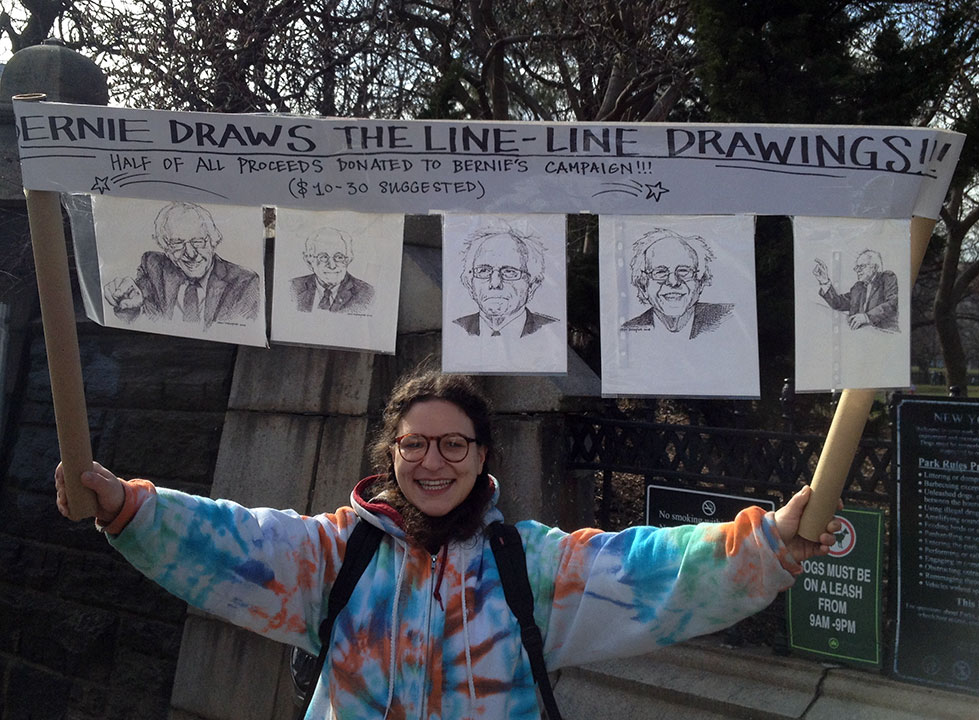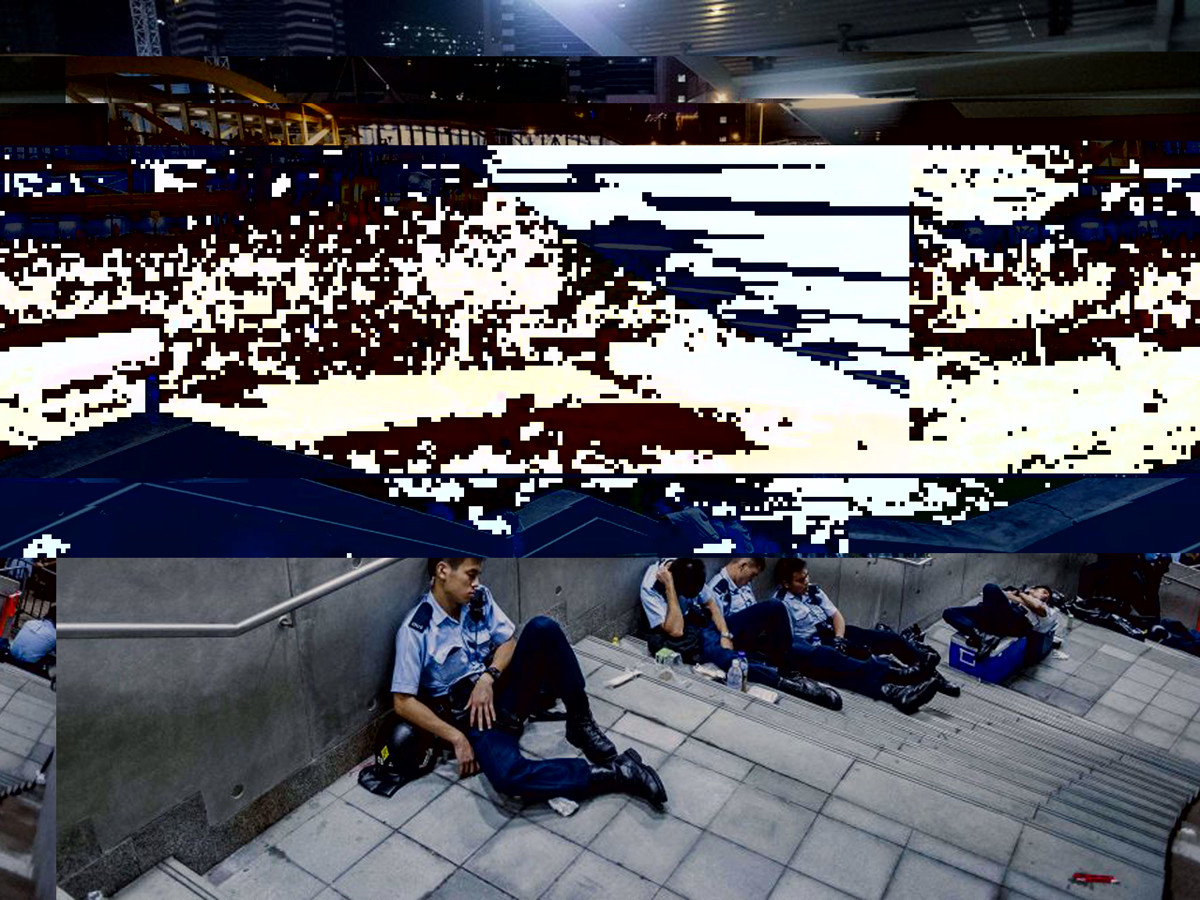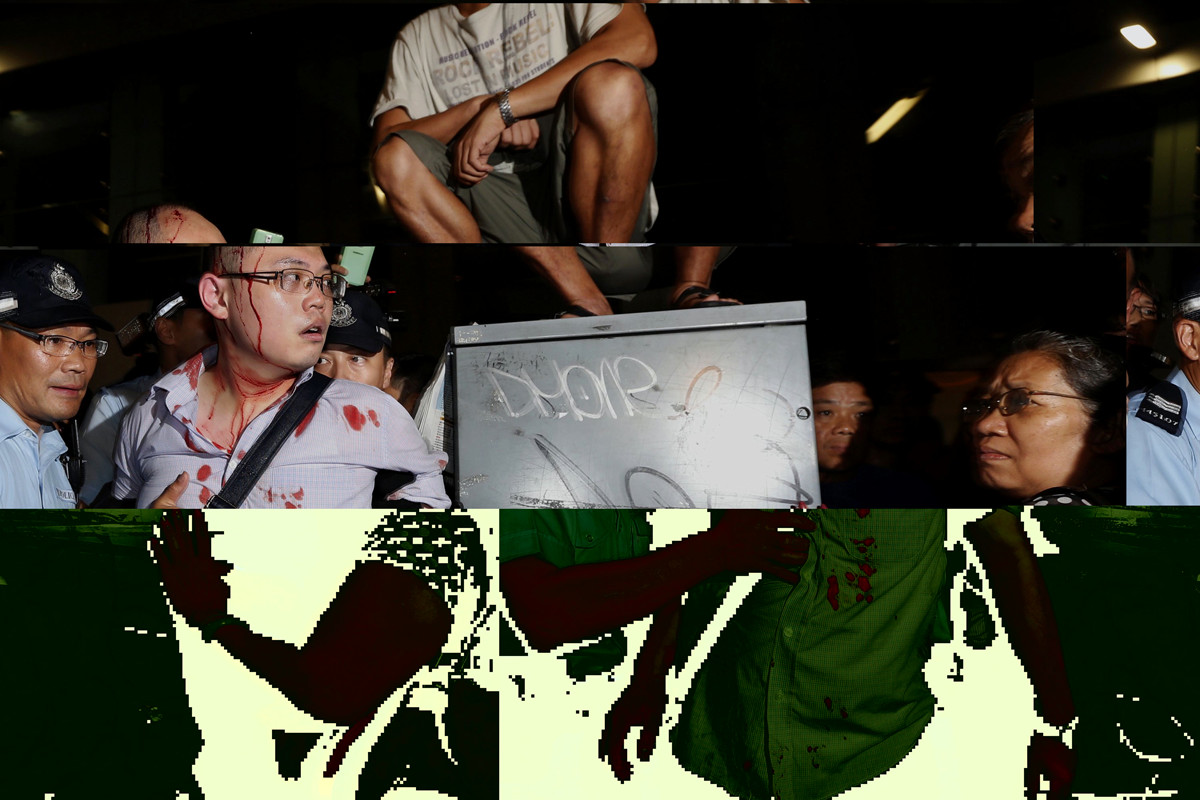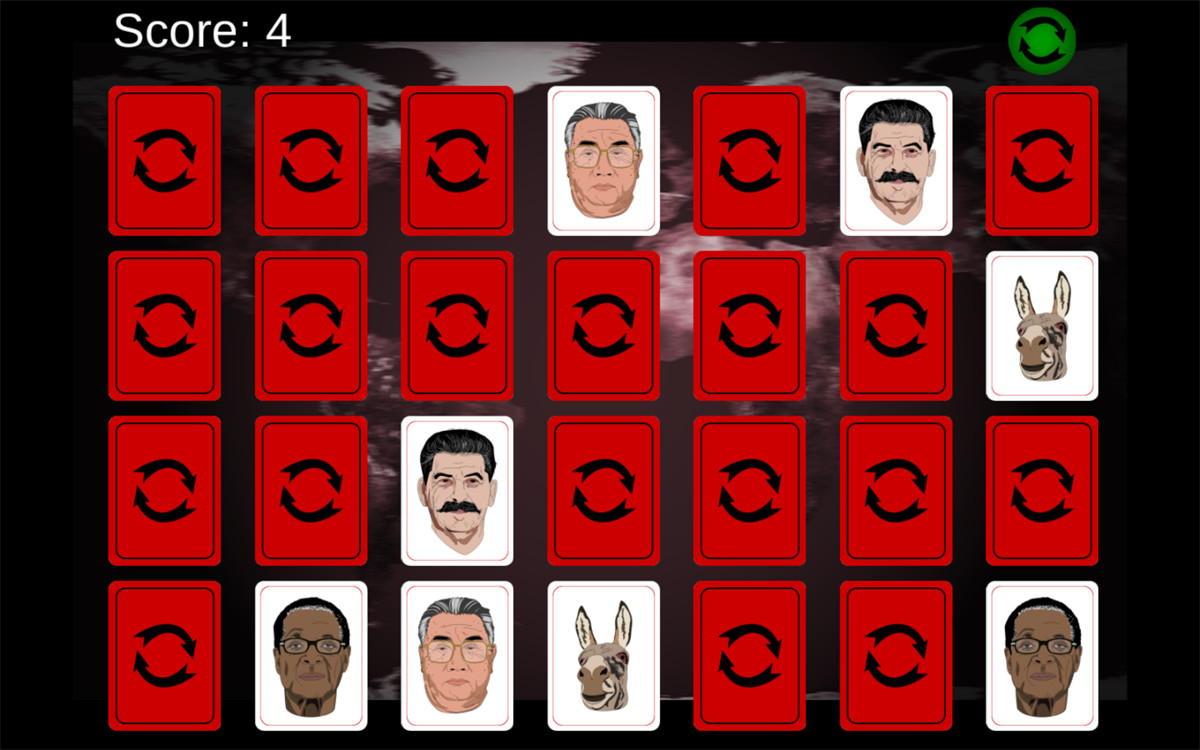Archive for the ‘politics’ Category
Drawings for Bernie!

On an outing to Fort Greene Park yesterday afternoon, I met Alevo Zkaynak at the entrance of the park. She was holding a home made banner declaring “BERNIE DRAWS THE LINE – LINE DRAWINGS!!!”. From the banner hung 5 terrific line drawings created by the artist to generate donations for Bernie. She told me that she was out of money to give to Bernie, so she made the drawings to sell; she’d send half the proceeds to the Bernie campaign.
It is this sort of youthful and earnest enthusiasm that makes me wish that Bernie Sanders Political Revolution did occur. Unfortunately as with Obama’s HOPE, the United States is far too divided for any revolution to occur whether it’s a revolution of bigotry and hate or one of openness and love. As with much of Obama’s tenure, the Republicans are blocking the President’s right to select a new Supreme Court judge. When our representatives are unwilling to do their job, it is amazing that any legislation gets done in this country. Change must occur, perhaps it will happen through today’s youth, people like Alevo Zkaynak.
Amnesia – a Card Matching Game
I’m currently teaching myself Unity by reading through Unity in Action and as an initial finished project, I’ve built a card matching game that is covered in the fourth chapter of this book. I decided to utilize the dictator portraits that I’ve been creating for a print and animation series titled “Drunk with Power”. The game is available online, so test your memory by matching the 14 dictators illustrated onto the cards in the game “Amnesia”. In case you are not able to identify some of the portraits and would like to know who they are, the illustrated dictators are: Somoza, Ortega, Stalin, Putin, Idris, Gaddafi, Batista, Castro, Smith, Mugabe, Hirohito, Kim Il-sung, the GOP and the Dems.
I could not not include the United States of America. By placing the mascots of the U.S. Democratic and Republican parties amongst the portraits of Latin American, Soviet, African, Middle Eastern and East Asian dictators, the viewer is asked to question the concentration of political power within only two political parties and the ideologies that they expound. Excluded from power are any third parties and alternative political views or social movements. Through the recent victory of Citizens United (2010), the concentration of power has been fortified by unlimited corporate spending on political campaigns to influence elections. The passing of this Constitutional law is akin to the oligarchies represented by the rest of the portraits. Just as with the countries controlled by the depicted dictators, the United States is not a democracy. Play “Amnesia”! (The portraits look a lot better when played full-screen.)
Mugabe Is Old
I have been working on a series of portrait illustrations of individuals that I consider akin to dictators over the past year. The series is titled “Drunk with Power”. The intention of the illustrations is to make them into animations which is happening very slowly. Occasionally, I’ll make a quick animation, such as the one above. There is also a web version of this animation that uses code for the background rather than triangles colored using markers: http://rmz.nyc/mugabe.html
Hong Kong Glitch
I don’t recall what compelled me to start saving images from the Hong Kong protests last year. However, as I saved them, I began manipulating the digital files by changing the files extension to be able to open them in a basic editor as text and to read the meta data on the images. As I did so, I would rearrange the data making up the image itself. It seemed appropriate to confuse the file by cutting data, changing the order of the data or adding new data. Not unlike the Occupy Movement here in the United States, the Umbrella Revolution appeared as a young and inspired population that would eventually dissipate against an all powerful ruling force. Perhaps, when this generation comes to power, they will recall the energy and desire of this time. I’ve decided to arrange the images into a small book that is available on Blurb or you can merely view the images online. Below are a few images from the series of 20.




Crimea to Putin
Over the past year, I’ve been slightly obsessed with Vladimir Putin. As the annexation of Crimea occurred in spring of 2014, I took in all the news as I tried to understand why in this day and age following two world wars and the cold war of the past century a world leader would behave in such a manner. I understand that Crimeans speak primarily Russian and not Ukrainian, that Crimea was part of Russia until 1954 and perhaps culturally the Crimean majority identify as Russian. But to make the power play of absorbing a portion of another country immediately following a revolution, strikes me as a land grab of another era not reflective of our globalized, pan-capitalist world. I of course wondered if Putin is today’s Stalin, as many other people make the connection. In considering this annexation, I assembled this animation as I work on a slightly less shorter animated portrait.
Six Year Old on Gay Marriage: “It’s none of my business”
My son and I were listening to WNYC this morning while having breakfast. The Morning Edition was reporting on the Supreme Courts upcoming decision regarding Gay Marriage. So my six-year old asked me what “Gay Marriage” is and I explained that it is when two people of the same gender want to be married and that currently in many states, it is not allowed, whereas here in New York gay couples are allowed to marry. So, he asked if they can marry here, why are they talking about it on the radio. I explained as best I could the Supreme Court and that if the judges decided that Gay Marriage is lawful, people would be able to marry in all states. And I asked what he thought – should gay couples have the right to marriage just as a man and a woman do across the country? He shrugged and said, “it’s none of my business, if they want to marry, sure.”
“The Surrender” by Stephen Maing
“The Surrender” by Stephen Maing
Occasionally, I see something that makes me reconsider the Libertarian platform as perhaps not being so ridiculous. The latest something to do so is the short documentary by Stephen Maing titled “The Surrender” which is currently available on First Look Media.
A simple conversation between Stephen Kim an intelligence analyst in the State Department and an ignorant Fox reporter James Rosen lead to the prosecution and 13 month prison sentence of Stephen Kim. The basis of this prosecution is a report that a UN Resolution would lead to further nuclear tests by North Korea. As Jon Stewart put it “that’s it, that’s the leak… North Korea has a nuclear test based economy.”
A good man looses his life savings fighting ridiculous accusations by the Obama administration using the Espionage Act to try and dig up whistle blowers. It’s difficult to not consider whistle blowers as the agents for a transparent government, one of the values espoused by Obama.
Why are our tax dollars going toward the conviction of innocent people who are trying to help build a better world? Of course Libertarian ideals and the desire to contribute toward a better government and country are at odds. Immediately after reconsidering Libertarianism, I recall… “oh ya, Libertarians must be land-owning white people who are pissed about taxes, like to have their guns and feel strongly that they had nothing to do with slavery or its aftermath. They probably home school their children and are against vaccinations.”
Once Stephen Kim’s prison term is up, he must show proof of employment. Later this year Stephen Kim will go from highly regarded State Department Analyst to a Beauty Product Salesman (Kim secured his employment at a beauty supply store before heading to jail).
U.S. Cuba Relations

Normalizing Relations between adversary nations leads to diplomacy and understanding.
In 1972 President Richard Nixon took a dramatic first step toward normalizing relations with the communist People’s Republic of China. In 1985 Reagan saw Mikhail Gorbachev as a viable negotiating partner. In 1989 the Berlin Wall fell. By the end of 1991, the Soviet Union had dissolved. The normalization of relations between the United States and adversary countries tends to lead to diplomatic change and a working relationship that mutually benefits both countries. For Jeb Bush and Marco Rubio to not recognize this reflects an ignorance of international relations. Change can only come about through communication and understanding.
Nicolás Dumit Estévez Interviews Ricardo Miranda Zúñiga
 As part of the exhibition “PLAYING WITH FIRE: Political Interventions, Dissident Acts, and Mischievous Actions” at El Museo del Barrio several interviews were conducted with the artists concerning their practice. Below is the interview that the curator Nicolás Dumit Estévez conducted with me for the exhibition. The exhibition continues on view until February 7th.
As part of the exhibition “PLAYING WITH FIRE: Political Interventions, Dissident Acts, and Mischievous Actions” at El Museo del Barrio several interviews were conducted with the artists concerning their practice. Below is the interview that the curator Nicolás Dumit Estévez conducted with me for the exhibition. The exhibition continues on view until February 7th.
NDE: Can you talk about the use of firearms in On Transmitting Ideology?
RMZ: Through the amplification of mass media, ideological rhetoric is a powerful cultural weapon. I wanted to make as transparent as possible the power of ideological speech and its transmission through the media; mounting the radios on to the forms of AK47s and Uzis immediately triggers this link – the transmission of ideological speech is a political weapon.
NDE: I had the opportunity to see images of the performance of On Transmitting Ideology in Berlin, Germany. What were some of the reactions from passersby? My understanding is that people in the streets encountered you, as well as a small cadre of performers carrying wooden AK47s? How did you go about recruiting participants to your piece?
RMZ: The march was one act of a 24 hour sound performance titled “Moving Forest” that was commissioned for “transmediale.08: CONSPIRE…” an annual art and digital culture festival in Berlin. The performance and call for participants was circulated during the festival, so it was festival participants that volunteered to be part of the performance. The march of 20 participants was from Haus der Kulturen der Welt to the public park Siegessäule with a stop by the mayor’s home. My constant fear was that of authorities stoping us, but police merely looked at us with disinterest. Also most pedestrians merely paused to watch us, some asked what we were doing and when English speaking, we had them listen to the audio montage. People who did so, generally understood the work and were only surprised by the extremism spoken in the historically famous speeches.
NDE: There is a great deal of debate between those who advocate for guns and those who want to ban them . I am wondering how On Transmitting Ideology may or may not position itself in the context of this push and pull.
RMZ: The representation of the gun is to reflect the violent nature of ideology and if one is to listen to the audio montage, it capture extremism. I consider both violence and extremism as negative characteristics of society. The reading of the work that is most in line with my goal in creating the work is that we as a society need to move away from both weapons and ideological extremisms – political and religious.
NDE: What are your thoughts about the politization of aesthetics. It has come to my attention that, while it is fashionable to make “political” work, politics are not a hip subject in the art world?
RMZ: I have little interest in the art world. I’m much more interested in art that exists outside of the art world; art that engages people who are not seeking art and may function outside the gallery or museum. I’m interested in art that attempts to weave itself into the fiber of everyday culture while investigating, questioning and perhaps critiquing normative culture to stir self reflection. Much of the exchange in the art world is to decorate the homes of the wealthy or perhaps to serve as an investment for the wealthy. Perhaps for the art collector, investing in work that portrays current day politics is a bad long-term investment choice and not the best home decoration. If art world work is political, it needs to be sufficiently abstracted or undefined to function as a commodity object, so that any political potential has been muted.
NDE: Making political art work entails a big responsibility and a challenge as well. How can art that is politically-conscious live beyond the art world and effect change in society at large? And is this the role of the artist?
RMZ: This is a tough questions, because I don’t know how one would measure the effect of politically charged work upon others whom it may inspire to act. I believe that as long as the drive to create political art is sincere – that the artist is compelled to make political art due to first-hand experience of injustice, inequality, the misuse of power, it is not the role of the artist to effect change. The role of the artist is to capture and convey.
This interview is part of Crossfire, a project conceived and edited by Nicolás Dumit Estévez for El Museo del Barrio.
Visualization of #ICantBreathe, #BlackLivesMatter, #HandsUpDontShoot
Using CartoDB user SRoghers has created a visualization of the hashtags #ICantBreathe, #BlackLivesMatter and #HandsUpDontShoot on Twitter
